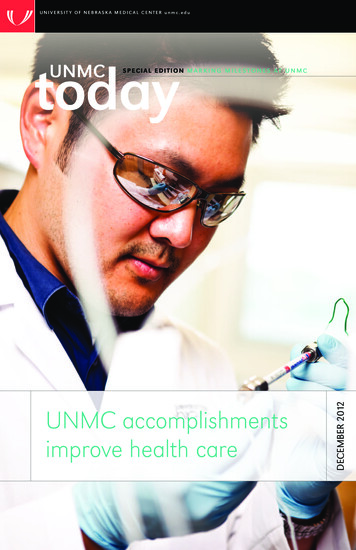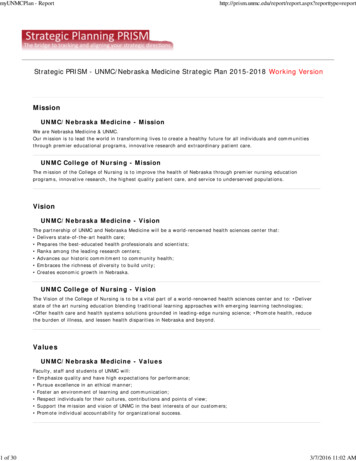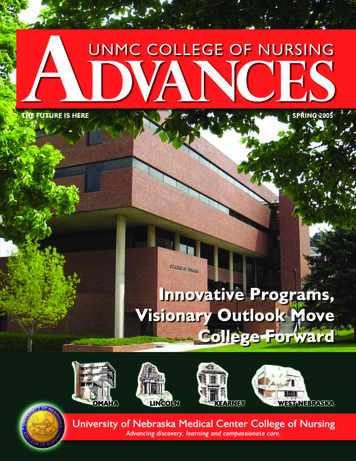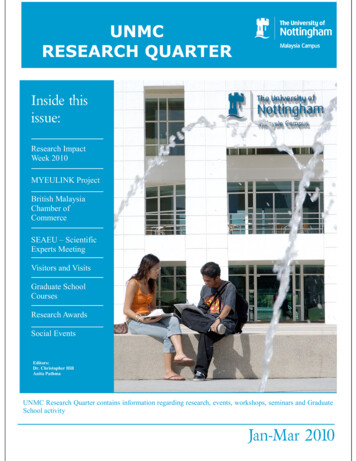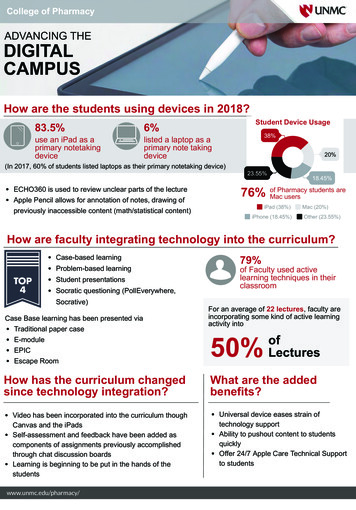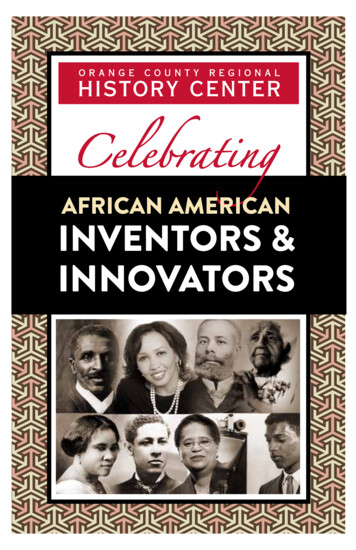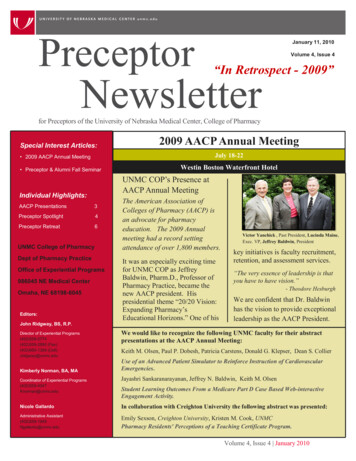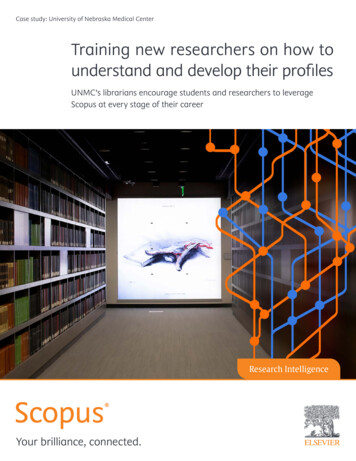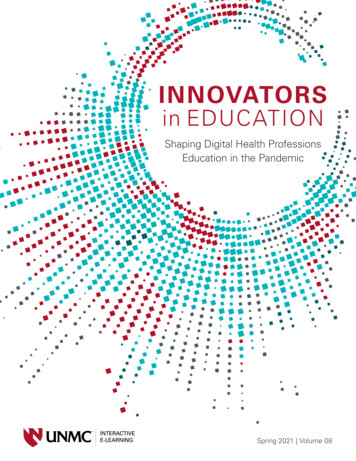
Transcription
INNOVATORSin EDUCATIONShaping Digital Health ProfessionsEducation in the PandemicSpring 2021 Volume 08
A M ES SAG E FROMH. DELE DAVIES, MD, MS, MHCMSenior Vice Chancellor for Academic AffairsI am proud to introduce our 2020-2021 Innovators in Education. Thisbooklet highlights our tenth cohort in the UNMC Funded E-LearningModule Awards Program, which comprises 17 teams of 43 studentdevelopers and 35 faculty advisors from Omaha, Lincoln and Kearney.As with other cohorts, a major success factor was the collaborativepartnership between the student and faculty groups. Faculty led theprojects with the commitment to incorporate the e-modules into theircourses and consulted with the students to generate creative ideas.In turn, the students offered creative engagement and e-learningdevelopment skills.The contributions and value of the e-modules created byour faculty and students are more important than everin light of the seismic shift in our educational deliverylandscape as a result of the COVID-19 pandemic.I want to express my gratitude and appreciation for all the hard work andinnovation that went into the creation of these e-learning projects. I hopeyou enjoy viewing them as much as I do.T H E E- G A LL ERY:access all the e-learningmodules — anytime, anywhere» unmc.edu/egallery
TA BL E OFC ontent sE- L E A RNING L E A D ERSHIPCLICK THE TITLEto view each abstract02 Experts who drive the future of UNMC E-LearningPRO JEC T A BST R AC T S04 R espirators and Their Use in Agriculture13 Cellular JunctionsDr. Chandran Achutan, Alexandra Farfalla, Emily GirardDr. Shantaram Joshi, College of MedicineCollege of Public HealthSydney Greer, Halle Mallard, Sarah SchlichteGraduate Studies05 D igital Design – Occlusal SplintDr. Gregory Bennett, Spencer Adams, Cameron Aitken,Selam Carlson, Isaac Langan, College of Dentistry06 Staging of Pressure InjuriesEmily Coffey, Ashley Jennings, Lizzy Kangas,14 N on-Invasive Ventilation (NIV) and PressureInjury (PI) PreventionCourtney Loecker, Dr. Suhasini Kotcherlakota,Austin Clark, Kaitlyn DuerstCollege of Nursing – Omaha DivisionKobe Slaughter, College of Nursing – Omaha Division07 Two-Part Series: Diabetes Medication Therapy& How to Use Various Diabetes EssentialsDr. Kristen Cook, Ashley Lopez, Dominic PoeppelCollege of Pharmacy08 I nterprofessional Team-Based Care of a Patientwith Cardiovascular Disease15 Bruxism Oral AppliancesDr. Julie Marshall, Karla Mejia, Ramanpreet Randhawa,College of DentistryDr. Brijesh Chandwani, St. Barnabas Hospital16 Neonatal ResuscitationDr. Courtney Kiser McLean, Dr. Ann Anderson Berry,Cristian Valquier, Kelsey Yamada, College of MedicineDr. Abbey Fingeret, Liliana Bronner, Dr. Furqan Khattak,Dr. Maheswari Mukherjee, College of Allied HealthMorgan Harris, Libby Moberg, College of MedicineProfessions09 Differential Diagnosis: Low Back Pain vs. Hip Pain17 Prenatal ScreeningDr. Megan Frazee, Andréas Remis, Henamari YbayJannelle Reynolds, Pamela Dickey, Jake Andreasen,College of Allied Health ProfessionsJessica Hartman, Hannah SchaufCollege of Allied Health Professions10 V ascular Supply to the Central Nervous SystemDr. Karen Gould, Dr. Rob Norgren, College of MedicineAndrew Duncan, Oliver Kitzerow, Graduate Studies18 Principles of Ethical Research in Clinical TrialsDr. Lynette Smith, Priyanka Chaudhary, Gaurav Kumar,College of Public Health11 A Physicist’s Primer for Effective PatientCommunicationDr. Megan Hyun, Dr. Abby Besemer, Dr. Diane Schott,Dr. Dandan Zheng, Sarah Wisnoskie, Jeffrey WongCollege of Medicine12 Radiation Detection & MeasurementDr. Megan Hyun, Dr. Diane Schott, Sarah Wisnoskie,Jeffrey Wong, College of Medicine Lisa Bartenhagen, Jana Koth, Kristel Eyrich,Michaela McClellen, Caleb McGowanCollege of Allied Health ProfessionsDr. Bruce Gordon, College of Medicine19 C ompanion Technologies: MolecularDiagnostics (lecture 1)Sarah Sprinkle, Dr. Amber Donnelly, Dr. MaheswariMukherjee, Rachael Neff, Shannon TinnellCollege of Allied Health Professions20 C ompanion Technologies: MolecularDiagnostics (lecture 2)Sarah Sprinkle, Dr. Amber Donnelly, Dr. MaheswariMukherjee, Kali Carroll, (Amanda) Caleigh Coyne,Jaime Wright, College of Allied Health Professions
I N N O V AT O R S I N E D U C AT I O N 2 0 2 1 E- L E A RNINGLeader shipOFFIC E OF INT ER AC T I V E E- L E A RNINGH. Dele Davies, MD, MS, MHCMSteph Langel, MASenior Vice Chancellor for Academic AffairsInstructional DesignerE-LearningPeggy Moore, MSEdDirector & Instructional Designer, E-LearningAssistant Professor, College of Allied Health ProfessionsApril ElkerProgram CoordinatorE-LearningTuggen Even, MSEdInstructional TechnologistE-LearningMegan BlusysCommunications & Media SpecialistAcademic AffairsE Z STUD I O:all-in-one videorecording studio» unmc.edu/EZStudio02
I N N O V AT O R S I N E D U C AT I O N 2 0 2 1 ST EERINGC ommit teeC H A IRSBetsy J. Becker, PT, DPT, PhD, CLT-LANAPeggy Moore, MSEdChair, Health & Rehabilitation SciencesDirector & Instructional Designer, E-LearningProgram Director & Associate ProfessorAssistant Professor, College of Allied Health ProfessionsCollege of Allied Health ProfessionsMEMB ERSChristine M. Arcari, PhD, MPHMary P. Niemiec, MAAssociate Dean for Academic and Student AffairsDirector, University of Nebraska Online& Associate ProfessorAssociate Vice President, University of NebraskaCollege of Public HealthDistance EducationPamela K. Carmines, PhDExecutive Associate DeanGraduate StudiesMelissa A. Diers, MEdDirector, IT Academic TechnologiesAssistant Professor, College of Allied Health ProfessionsWilliam Glass, MSDirector, Visualization and TechnologyiEXCELDonald G. Klepser, PhD, MBAAssociate Professor& Associate Dean for Academic AffairsCollege of PharmacySuhasini Kotcherlakota, PhDAssistant Professor & Instructional DesignerCollege of NursingLinda M. Love, EdDDirector, Faculty DevelopmentAssistant Professor, College of MedicineDan NovinskiStudent SenateCollege of MedicineFrank Pietrantoni, MSDirectorOffice of Health Professions EducationNebraska MedicineYun Saksena, BDSc, MMSc, DMDAssociate Dean for EducationCollege of DentistryLynnette Leeseberg Stamler, PhDAssociate Dean & ProfessorCollege of NursingGeoffrey A. Talmon, MD, MEdAssociate Dean for Medical Education & ProfessorCollege of MedicineTammy L. Webster, PhD, MPA, RT(R)(M),FAEIRSAssistant Dean for Academic AffairsCollege of Allied Health Professions03
I N N O V AT O R S I N E D U C AT I O N 2 0 2 1 Respiratorsand Their Usein AgricultureFACULTY PROJECT DIRECTORLung diseases are the most common cause of occupational illnesses inthe United States. Many occupations use respirators to protect againstChandran Achutan, PhD, CIHCollege of Public Healthrespiratory hazards, as required by the OSHA Respiratory ProtectionStandard. Although many agricultural workers are exempt from theserequirements, respiratory protection is valuable for maintaining lung health.STUDENT TEAM MEMBERSAlexandra FarfallaCollege of Public Health2nd -Year PhD studentEmily GirardCollege of Public HealthClass of 2021Respirator terminology can be confusing, leading to somemisuse. This module aims to discuss differences betweenmasks and respirators and highlight some of their features.Additionally, reviewing the maintenance and storage forreusable respirators is beneficial to ensure proper workingorder and longevity.This module divides the course content into sections, each addressingone of the objectives: differences between respirators and other facecoverings, proper storage and maintenance, and use in agriculture. Thereis an assortment of interactions including matching, animation, sortingand review questions that require the application of previously presentedmaterial. These interactions enhance traditional learning methods andencourage participation. They reinforce key concepts and help gauge thelearner’s understanding of the presented material.There is a summative assessment at the end of the module. Outcomeswill be statistically analyzed to determine the usefulness of the modulefor enhancing respirator knowledge. Other metrics, such as time ofcompletion, will also be gathered.The module may be used in addition to lecture material or as part of aflipped learning format. It is designed for use by students and agriculturalworkers alike. Understanding personal protective equipment is beneficialfor public health professionals working to improve workplace safety. It canCLICK HEREto view the modulealso provide a short, educational session for workers who want to learnmore about respirators or to just get a review.04
I N N O V AT O R S I N E D U C AT I O N 2 0 2 1 Digital Design –Occlusal SplintFACULTY PROJECT DIRECTORBruxism is a physiologic action that typically occurs overnight whenGregory Bennett, DMDCollege of Dentistryintended for the patient to wear overnight to distribute the occlusal forcespatients clench or grind their teeth involuntarily. A bruxism orthotic isover the entire dentition rather than on individual teeth. Orthotics can bemade by students in one appointment using new 3D scanning technologySTUDENT TEAM MEMBERScoupled with state-of-the-art software and a stereolithography apparatus(resin 3D printer).Spencer AdamsCollege of DentistryClass of 2021Cameron AitkenCollege of DentistryClass of 2020Selam CarlsonCollege of DentistryClass of 2022Isaac LanganCollege of DentistryClass of 2023This e-module provides UNMC College of Dentistrystudents and faculty a step-by-step protocol to scan,design and print their own bruxism orthotic in conjunctionwith two courses offered to dental students: TMJDisorders and Digital Dentistry.Through quiz questions strategically placed throughout the module anda final summative assessment, participants shift their focus to the mostimportant concepts/protocols as well as common mistakes in the designand printing process. At the completion of the e-module, clinicians areable to offer their patients an accurate and effective orthotic at reducedcost and time as compared to the traditional means of production.Modern dentistry continues to embrace innovative technology to providea more effective and convenient treatment for today’s patients. With theCollege of Dentistry’s focus on providing students the opportunity touse and learn these exciting technologies, it ensures patients receive thehighest level of care and students receive the highest-level education tosucceed in this modern dental age.CLICK HEREto view the module05
I N N O V AT O R S I N E D U C AT I O N 2 0 2 1 Staging ofPressure InjuriesFACULTY PROJECT DIRECTORThis project was chosen to better facilitate learning to nursing studentsabout staging of pressure injuries.Emily Coffey, MSN, RN, MHACollege of Nursing – Omaha DivisionThis interactive module guides learners in the staging ofpressure injuries through thorough content explanationSTUDENT TEAM MEMBERSAshley JenningsCollege of Nursing – Omaha DivisionClass of 2021Lizzy KangasCollege of Nursing – Omaha DivisionClass of 2021Kobe SlaughterCollege of Nursing – Omaha DivisionClass of 2021and interactive learning checkpoints.It also covers the common terminology used whendetermining the stage of a pressure injury.This interactive module is supplemental to the pressure injury contentprovided to semester 1 nursing students during their Patient CenteredCare 1 course.In this module, we check the learner’s knowledge with interactive dragand drop, hot spot, and matching quizzes. After completion of thismodule, learners are able to identify the different characteristics ofpressure injuries and to properly stage pressure injuries.CLICK HEREto view the module06
I N N O V AT O R S I N E D U C AT I O N 2 0 2 1 T WO-PART SERIES:» DiabetesMedication Therapy» How to Use VariousDiabetes EssentialsFACULTY PROJECT DIRECTORThe prevalence of diabetes continues to increase in the United states.Currently, 12.5% of the U.S. population has diabetes, and this number isKristen Cook, PharmD, BCPSCollege of Pharmacyprojected to continue to increase.With the prevalence of diabetes increasing, it is importantSTUDENT TEAM MEMBERSAshley LopezCollege of PharmacyClass of 2021Dominic PoeppelCollege of PharmacyClass of 2021for future pharmacists to understand the pharmacotherapyused to manage patients with diabetes and educatepatients on diabetes medications and devices.These two modules contain application of evidence-basedpharmacotherapy, animations, quizzes and patient education videos.They also serve as a refresher for students to be able to apply thispharmacotherapy in class and in practice. The modules are a furtherresource for students to review drug information in didactic coursesand reinforce application of the pharmacotherapy with embeddedassessments.These projects bring visual representations and interactivity to the coursematerial and assist learners better understand the pharmacotherapy ofdiabetes.CLICK HEREto view part oneto view part two07
I N N O V AT O R S I N E D U C AT I O N 2 0 2 1 InterprofessionalTeam-Based Careof a Patient withCardiovascularDiseaseInterprofessional TopicFACULTY PROJECT DIRECTORThis module will be used for the Interprofessional Education Coil forAbbey Fingeret, MD, MHPTT, FACSCollege of Medicinecurriculum. Students will review the team-based interprofessionalthe College of Medicine within the circulatory block of Phase 1 of thedelivery of care of a patient with cardiovascular disease using a casebased approach.STUDENT TEAM MEMBERSMorgan HarrisCollege of MedicineClass of 2022Libby MobergCollege of MedicineClass of 2023This module introduces students to the roles andresponsibilities of non-physician professionals whocontribute to the care of the patient. This topic waschosen in order to highlight numerous members of thehealthcare team that students may work with in a similarsituation in the future.The interactive module has knowledge checkpoints and a summativeADDITIONAL FACULTY ADVISORSLiliana Bronner, MHSA, MBACollege of MedicineFurqan Khattak, MD, MSCollege of MedicineCLICK HEREto view the moduleassessment to evaluate student learning of the module content andinformation that coincides with content covered in prior lectures receivedin class. This module is used in conjunction with an in-person activity inorder to further solidify concepts.08
I N N O V AT O R S I N E D U C AT I O N 2 0 2 1 DifferentialDiagnosis:Low Back Painvs. Hip PainFACULTY PROJECT DIRECTORExposure to a complex clinical case scenario introduces clinicalchallenges that are difficult to simulate in an academic environment. TheMegan Frazee, DPT, OCS, MTC,FAAOMPTCollege of Allied Health Professionsability to differentiate between similar presentations, such as with hipand low back pain, is the foundation to providing individualized care.This module simulates three initial clinical evaluationSTUDENT TEAM MEMBERSprocesses: review of patient intake paperwork, subjectiveinterview and objective examination. To further simulateAndréas RemisCollege of Allied Health ProfessionsClass of 2022Henamari YbayCollege of Allied Health ProfessionsClass of 2022a clinic environment, the learner creates an on-goingdifferential diagnosis list from scratch, rather than apre-made list of options. With these components,students can observe how a differential diagnosis listevolves and apply their knowledge to a patient case.Throughout the module, course material is integrated into interactivelearning elements, such as quizzes and text fields to promote contentretention. After completing the project, a classroom discussion willreview the module’s main topics. Students then build off the case bydeveloping a treatment plan for the patient’s final diagnosis.There is an exit survey with a written feedback option. Analytics,including answers to questions throughout the e-module, will becollected for research purposes.The ever-growing need for accessible learning material sets a precedentfor e-modules that prepare learners for clinical environments. Clinicalreadiness is assessed throughout the curriculum in the form of writtenand practical exams. However, there are limited opportunities to selfevaluate problem-solving skills. This module helps fulfill this need byproviding a flow that is analogous to that of the clinical environment.The embedded videos and layout provide a digestible canvas for theCLICK HEREto view the modulecontemporary learner.09
I N N O V AT O R S I N E D U C AT I O N 2 0 2 1 Vascular Supplyto the CentralNervous SystemFACULTY PROJECT DIRECTORSThis e-module focuses on the vasculature of the central nervous system(CNS). In addition to enhancing comprehension of the neurovasculature,Karen Gould, PhDCollege of Medicinethe e-module provides students with an opportunity to apply thisRob Norgren, PhDCollege of MedicineThis content is covered in lecture format, but it is a challenging topic, andknowledge in formative and summative assessments.an e-module that allows students to review this content at their ownSTUDENT TEAM MEMBERSpace is extremely valuable.In this e-module, students are guided through key lectureAndrew DuncanGraduate StudiesClass of 2024Oliver KitzerowGraduate StudiesClass of 2024content to facilitate identification of the vasculature in theCNS and recognition of the structures that are perfused byspecific arteries/branches using an interactive format.Students complete a series of integrated quiz questions to aid in selfassessment of their content knowledge. The students’ ability to applythis knowledge is tested using questions focused on the identificationof arteries and the region(s) of the CNS supplied by a specific artery orbranch. Such questions help the students connect their understanding ofthe vasculature of the CNS with the relevant neuroanatomy.The e-module utilizes digital images of gross brains, magnetic resonanceangiographies, and animated cartoon images to engage the students andcultivate their understanding.CLICK HEREto view the module10
I N N O V AT O R S I N E D U C AT I O N 2 0 2 1 A Physicist’sPrimer forEffective PatientCommunicationFACULTY PROJECT DIRECTORMedical physicists are often thought of as behind-the-scenesMegan Hyun, PhD, DABRCollege of Medicinecommunicators. However, communication skills are essential to amembers of the Radiation Oncology team, even stereotyped as poormedical physicist’s job, and there are strong ethical and clinical reasonsto offer physicist-patient consultations.STUDENT TEAM MEMBERSSarah WisnoskieCollege of MedicineClass of 2021Jeffrey WongCollege of MedicineClass of 2022This module presents the learner with the justificationfor physicists to consult with patients, as well asthe strategies and skills they need to be effectivecommunicators in this context. It also allows the learnerto practice through an interactive simulation exercise.The module guides the learner through essential communication skillsand strategies specific to their role as a Radiation Oncology physicist,ADDITIONAL FACULTY ADVISORSincorporating interactions that keep the learner engaged. We employa unique assessment tool by showing the learner a physics-patientAbby Besemer, PhD, DABRCollege of Medicineconsultation and asking them to identify effective and ineffective uses ofDiane Schott, PhDCollege of MedicineA branched-scenario simulation exercise is incorporated into theDandan Zheng, PhD, DABRCollege of Medicineconsequences of how they communicate. The learner views a promptthese strategies.module, so the learner can apply their knowledge and see the potentialfrom the patient such as “Does radiation hurt?” and chooses thephysicist response. The response and the patient’s reaction are displayed,followed by the next prompt. Through this exercise, the learner engagesin a patient consultation, receiving immediate feedback about theirchoices and the impact they have on patient care.This module will be incorporated into UNMC’s Medical PhysicsResidency Program, but may also serve as a training tool for practicingphysicists or to help justify the utility of physicist-patient consultations toany Radiation Oncology department.CLICK HEREto view the module11
I N N O V AT O R S I N E D U C AT I O N 2 0 2 1 12Radiation Detection& MeasurementInterprofessional TeamFACULTY PROJECT DIRECTORRadiation can be used for the diagnosis and treatment of disease, butit is invisible to the casual observer. The measurement and detection ofMegan Hyun, PhD, DABRCollege of Medicineradiation is therefore a critical yet challenging aspect of medical physics.This module helps learners understand how four types ofSTUDENT TEAM MEMBERSKristel EyrichCollege of Allied Health ProfessionsClass of 2021Michaela McClellenCollege of Allied Health ProfessionsClass of 2021Caleb McGowanCollege of Allied Health ProfessionsClass of 2021Sarah WisnoskieCollege of MedicineClass of 2021Jeffrey WongCollege of MedicineClass of 2022ADDITIONAL FACULTY ADVISORSLisa Bartenhagen, MS, RT(R)(T)College of Allied Health Professionsradiation detectors “see” radiation, the pros and cons ofeach type, and how these detectors are used in a clinicalsetting.Animations and demonstration videos present the material in a visuallystimulating way that enhances retention of the material and shows thelearner how the knowledge will be helpful in their clinical role. Interactiveassessments are incorporated for each detector type to help the learnerrecall the properties and operating principles. At the end of the module,the learner has the opportunity to bring everything together by selectingthe most appropriate device for several clinical applications and byrecognizing the detector properties that contribute to these decisions.The module is aimed at radiation therapist students and is intended toserve as an engaging alternative to a recorded lecture, allowing a flippedclassroom model where classroom time is spent on active learningactivities. However, the module may also be used as a stand-alonereview for medical physics and radiation oncology residents.Results from the module assessments, in addition to a post-modulesurvey, will be analyzed to ascertain the effectiveness of the material foreach group of learners.Jana Koth, MPH, RT(R)(T)College of Allied Health ProfessionsDiane Schott, PhDCollege of MedicineCLICK HEREto view the module
I N N O V AT O R S I N E D U C AT I O N 2 0 2 1 Cellular JunctionsFACULTY PROJECT DIRECTORShantaram Joshi, PhDCollege of MedicineCellular Junctions was created to provide students witha basic overview of the complex, multiprotein cellularstructures between adjacent cells or between cells andthe extracellular matrix collectively known as cell junctions.STUDENT TEAM MEMBERSSpecifically, this e-module covers several junctions includingSydney GreerGraduate Studies4th -year PhD studentcomponents of each of these junctions, as well as some of their uniqueHalle MallardGraduate Studies5th -year PhD studentBy providing relatable examples, interactive slides and frequent reviewSarah SchlichteGraduate Studies4th -year PhD studenttight junctions, adherent junctions, desmosomes, gap junctions,hemidesmosomes and focal adhesions. The functional and molecularfeatures, are discussed.questions, this e-module can serve either as the foundation that canbe built upon in the traditional lecture setting or as a supplement to atraditional lecture to clarify these fundamental concepts. In addition, asummative review at the end of the module requires critical thinking andsynthesis of concepts to answer higher-order application questions.As such, almost everyone can benefit from the Cellular Junctionse-module including but not limited to medical students, physicaltherapists, physician’s assistants, nurses, allied health professionals andgraduate students. The concepts covered within the e-module are criticalfor a basic understanding of cell structure and function, an area of studyapplicable in many disciplines, and will contribute to a better-preparedhealth care professional and scientific researcher.CLICK HEREto view the module13
I N N O V AT O R S I N E D U C AT I O N 2 0 2 1 Non-InvasiveVentilation (NIV)and Pressure Injury(PI) PreventionFACULTY PROJECT DIRECTORThis project was designed to address the issue of pressure injury (PI)development in patients requiring non-invasive ventilation (NIV).Courtney Loecker, MSN, APRN-NP,AGACNP-BCCollege of Nursing – Omaha DivisionDue to COVID-19, the use of NIV has increased, leadingto heightened rates of PIs. This module provides a highlevel overview that focuses on key areas for PI preventionSTUDENT TEAM MEMBERSAustin ClarkCollege of Nursing – Omaha DivisionClass of 2022Kaitlyn DuerstCollege of Nursing – Omaha DivisionClass of 2022ADDITIONAL FACULTY ADVISORSuhasini Kotcherlakota, PhDCollege of Nursingin this vulnerable population. It focuses the learner’sattention on simple, evidence-based interventions that canimprove patient outcomes.Content is provided in short segments, followed by review questions topromote retention. Review questions dispersed throughout the moduleare designed to provide a variety of engagement methods and are utilizedto reinforce learning.The topic of NIV use is taught in a variety of programs, includingundergraduate nursing, graduate nursing, respiratory therapy andmedicine, although PIs associated with NIV is not frequently discussed.This module serves as an adjunct lesson to cover this topic. Knowledgeof risks and implementation of the interventions discussed in this modulecan promote better patient satisfaction, comfort and outcomes.CLICK HEREto view the module14
I N N O V AT O R S I N E D U C AT I O N 2 0 2 1 Bruxism OralAppliancesFACULTY PROJECT DIRECTORDiagnosis and treatment of patients exhibiting bruxism can beJulie Marshall, DDS, MSCollege of DentistryIt is vital to recognize appropriate treatment modalities including thechallenging and may be associated with many other complex conditions.selection of proper oral appliance design, fabrication materials, CDTcoding and when referral to an Orofacial Pain specialist is indicated.STUDENT TEAM MEMBERSAlthough oral appliances may have similar features, each of them has adifferent purpose. They can be designed to manage signs of bruxism orKarla MejiaCollege of DentistryClass of 2022Ramanpreet RandhawaCollege of DentistryClass of 2022to provide an adjunctive role for other complex orofacial conditions.This e-module is a visual and auditory interactive guideto support learners in their understanding of bruxism andassociated oral appliances. It guides the learner to selectthe appropriate oral appliance based on patient needs.Hot buttons provide visual examples and comparisons toADDITIONAL FACULTY ADVISORBrijesh Chandwani, DMDSt. Barnabas HospitalNew Yorkenhance understanding.The content can be used as supplemental acquisition of foundationalknowledge during a preclinical Temporomandibular Disorders course fordental students, as an adjunct to seminar discussions with postgraduatedental residents, and as a review for both novice and experiencedclinicians prior to patient care.The module contains short questions/quizzes used after each topic andprovides feedback to retain key points on each section. The two patientcase-based summative assessments with five questions each test thelearners’ retention and challenge their critical thinking.Upon completion of this e-module the learners will be able to identifysigns and symptoms of bruxism more easily during their patientassessments, educate patient about bruxism and select the appropriateappliance according to their patient needs.CLICK HEREto view the module15
I N N O V AT O R S I N E D U C AT I O N 2 0 2 1 NeonatalResuscitationInterprofessional TeamFACULTY PROJECT DIRECTORNeonatal resuscitation is a vital part of pediatric training for both medicalstudents and residents. Approximately 10% of 4 million babies bornCourtney Kiser McLean, MD, MSCollege of Medicinein the U.S. each year require resuscitation at the time of birth, whichnecessitates skilled attendees at every single delivery. Neonatalresuscitation has a recommended step-wise approach for care focusingSTUDENT TEAM MEMBERSon assessment, interventions and monitoring their response throughpositive pressure ventilation, intubation, chest compressions andCristian ValquierCollege of MedicineClass of 2021Kelsey YamadaCollege of MedicineClass of 2021administration of epinephrine.This topic was chosen to aid pediatric residents in arefresher during their month-long rotation in the neonatalintensive care unit (NICU). Their dedicated neonatalresuscitation training occurs every two years and doesnot correlate with their clinical time in the NICU. ThisADDITIONAL FACULTY ADVISORSAnn Anderson Berry, MD, PhDCollege of MedicineMaheswari Mukherjee, PhD, MSc, BPT,CT(ASCP) CMCollege of Allied Health Professionscourse will provide the background refresher knowledgebefore they do hands-on skills and simulation. Currently,the information review requires faculty time that couldbe better served with hands-on training, simulationand debriefing.The assessment of the module will look for understanding of keyfactors of neonatal resuscitation, such as the need for positive pressureventilation, the importance of thermoregulation, and how to identifythe steps (including when to initiate chest compressions and provideepinephrine). Current training includes monitoring of neonatal simulationfor learners. We plan to monitor learner’s simulation performancetechniques comparing learners who received a standard lecture andthose who go through the e-learning module.CLICK HEREto view the module16
I N N O V AT O R S I N E D U C AT I O N 2 0 2 1 Prenatal ScreeningFACULTY PROJECT DIRECTORPrenatal care is a complex but important aspect of medicine thatJannelle Reynolds, MPAS, PA-CCollege of Allied Health Professionscertification board testing.physician assistants must be proficient in for use in their practice and onThe Prenatal Screening module uses a patient case toSTUDENT TEAM
Module Awards Program, which comprises 17 teams of 43 student . Caleigh Coyne, Jaime Wright, College of Allied Health Professions 04 Respirators and Their Use in Agriculture Dr. Chandran Achutan, Alexandra Farfalla, Emily Girard . Assistant Professor, College of Allied Health Professions April Elker Program Coordinator E-Learning
